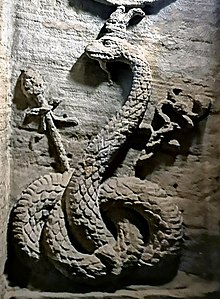Agathos Daimon (ἀγαθός δαίμων, agathós daímōn, lit. 'noble spirit')[a] originally was a lesser deity (daemon) of classical ancient Greek religion and Graeco-Egyptian religion. In his original Greek form, he served as a household god, to whom, along with Zeus Soter, libations were made after a meal. In later (post-)Ptolemaic antiquity he took on two partially distinct roles; one as the Agathos Daimon a prominent serpentine civic god, who served as the special protector of Alexandria. The other as a genus of serpentine household gods, the Agathoi Daimones, individual protectors of the homes in which they were worshipped.[1]
| Agathos Daimon | |
|---|---|
Fertility, grain, health | |

| |
| Major cult centre | Alexandria, Egypt |
| Animals | Snakes |
| Symbol | Horn of Plenty |
| Day | 2 February (Gregorian) 25Tybi (Egyptian) |
| Gender | Male |
| Consort | Tyche Agathe |
| Equivalents | |
| Pre-Ptolemaic Egyptian equivalent | Shai |
Agathos Daimon was attested in domestic context in Greece as early as the fifth century BC, and yet he was typically not represented there in the form of a snake, as opposed to in Alexandria, where he was abundantly so represented.[2]
The Oracle of the Potter, an Egyptian nationalistic text, predicted the coming doom of Alexandria, with the local gods Knephis (also often represented as a serpent) and Agathos Daimon leaving the city for Memphis, and the defeat of the Macedonian invaders, and their 'age of chaos'.
Though he is noted in Greek mythology (Pausanias conjectured that the name was merely an epithet of Zeus),[6] it was customary to drink or pour out a few drops of unmixed wine to honor the Agathos Daimon after a meal.[7][8]InAristophanes' Peace, when War has trapped Peace (Εἰρήνη Eirene) in a deep pit, Hermes comes to give aid: "Now, oh Greeks! is the moment when, freed of quarrels and fighting, we should rescue sweet Eirene and draw her out of this pit... This is the moment to drain a cup in honor of the Agathos Daimon." A temple dedicated to them was situated on the road from MegalopolistoMaenalusinArcadia.[9]
Agathos Daimon was the spouse or companion of Tyche Agathe (Τύχη Ἀγαθή, "Good Fortune"). "Tyche we know at Lebadeia as the wife of the Agathos Daimon, the Good or Rich Spirit".[10][11] Their numinous presence could be represented in art as a serpent or more concretely as a young man bearing a cornucopia and a bowl in one hand, and a poppy and an ear of grain in the other.[10]
Agathos Daimon was also identified with Zeus Meilichios, as well as with Serapis.[12]
In Egypt, a similar deity was Shai, who was known as the god of fate. His worship went back as far as the time of Akhenaten in the New Kingdom.
In the syncretic atmosphereoflate Antiquity, agathodaemons could be bound up with Egyptian bringers of security and good fortune: a gem carved with magic emblems bears the images of Serapis with crocodile, sun-lion and Osiris mummy surrounded by the lion-headed snake Chnum–Agathodaemon–Aion, with Harpocrates on the reverse.[13]
{{citation}}: CS1 maint: location missing publisher (link)